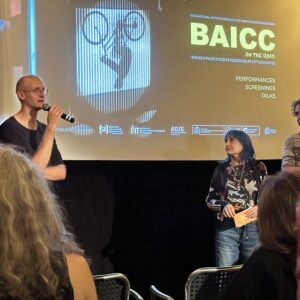We bring together two old friends of the festival, very dear to (S8): Pablo Marín, to whom we are devoting a complete episode of our program Camera Obscura, and Canadian filmmaker and researcher Stephen Broomer. Broomer wrote about Marín in his article, published in Desistfilm, Invisible River: Films by Pablo Marín. Here we share with an excerpt where he delves into Marín’s Denkbilder, one of the films included in the program.
Marín made Denkbilder (2013) between two cities, in a process he describes as “building something close to a cartography of remembrances.” Images from nature taken in Buenos Aires combine with street photography and portraits of zoo animals shot in Berlin. A polar bear, a hippopotamus, a goat, a tiger, form one layer against which Marín superimposes flashing, fluctuating images, of ambiguous origin. The central aesthetic act of the film is one of frame alternation – an image is fractured, broken up with black frames, beneath which is a stable (continuous) layer of image. The film begins with faint and distant light, of the sun reflected in rainwater. Over this, trees appear, a few frames of image divided by a few frames of black. The flashing trees give way to a parking lot lamppost, which spins like a mobile. Marín’s geometric sense of composition cuts triangles of sky from stone angles formed by the outlines of buildings. A woman’s silhouette, in profile, is the primary human presence in the film. Later we see her legs and a cigarette in her hand, but she is imposed upon by the stroboscopic actions that advance sequence to sequence. The flashing images shift from stable (consistent) compositions to zooms, zooming in and out with each alternation. Compositions are likewise reframed rapidly along the vertical and horizontal axes, the image-orientation thrown into flux. If xoxo developed from preconceived structures – the bodily performance, the graph-giving pans – then Denkbilder develops along a more intuitive line, in continuity with Marín’s earlier films such as Diario colorado, in its openness to the miracle of insight. This improvisatory image-taking, considered within the structure of his formal conceit (of vibrating presence-and-absence), forces his structural conceit to surrender to chance associations.






